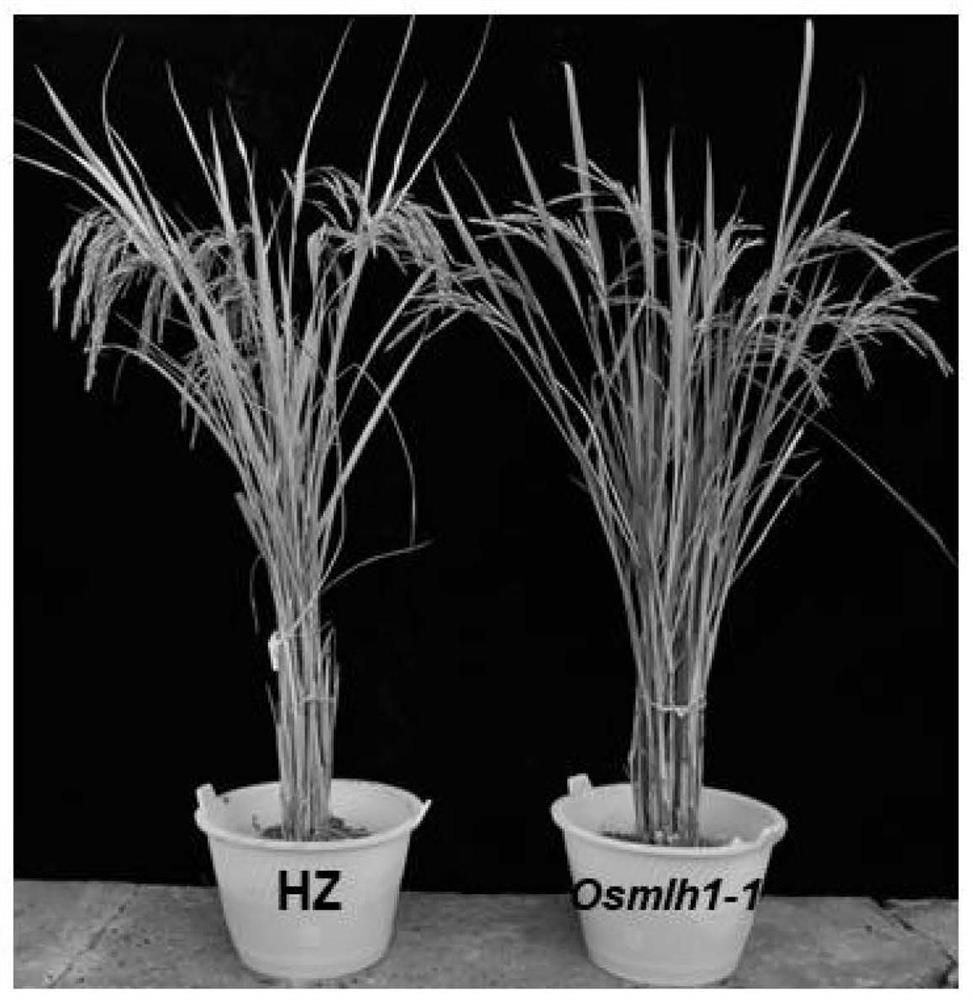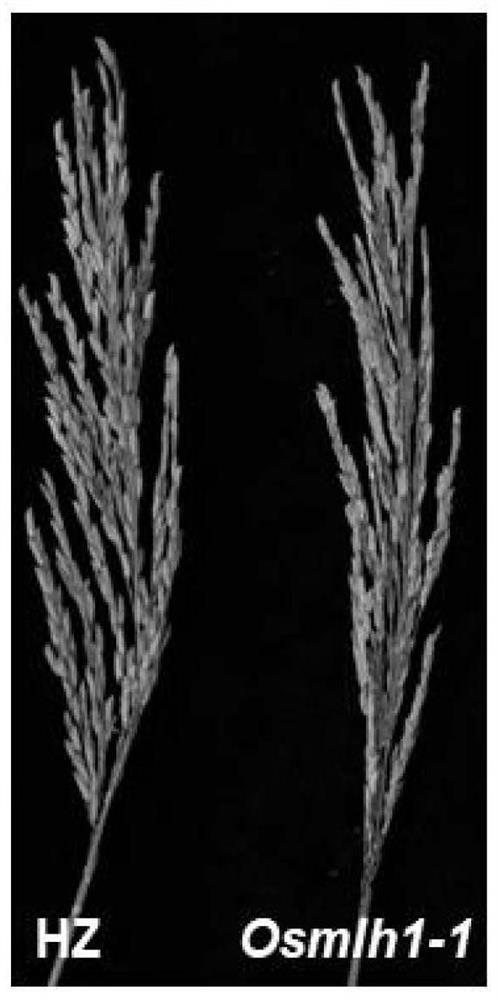Mutant genes for regulating and controlling female development of rice, proteins encoded by mutant genes, application of mutant genes and primers
A gene encoding and mutation technology, applied in the field of genetic engineering, can solve the problems of less utilization and less female sterility genes
- Summary
- Abstract
- Description
- Claims
- Application Information
AI Technical Summary
Problems solved by technology
Method used
Image
Examples
Embodiment 1
[0035] Example 1: Discovery of OsMLH1 mutant genes Osmlh1-1 and Osmlh1-2 that regulate rice female development
[0036] The full-length CDS (2175bp) sequence of the unmutated rice OsMLH1 gene is shown in SEQ ID No.1, and the unmutated protein sequence (724aa) encoded by the rice OsMLH1 gene is shown in SEQ ID No.2.
[0037] Through sequence alignment and target site rules, a specific target site 5'ATCGATGGGGTTCAGAGGGGAGG3' was selected on the second exon of the OsMLH1 gene, and the Cas9 gene editing vector system of monocotyledonous plants of Liu Yaoguang's team was selected: the CRISPR / gRNA vector was pYL- U3 / U6a~c-gRNA, the CRISPR / Cas9 binary vector is pYLCRISPR / cas9-MT (I), first design the target site linker primers (including upstream primer gRNA-F and downstream primer gRNA-R, respectively as SEQ ID NO. 9 and shown in SEQ ID NO.10):
[0038] gRNA-F: GGCATCGATGGGGTTCAGAGGGG;
[0039] gRNA-R: AAACCCCCTCTGAACCCCATCGA;
[0040] Ligated and amplified with the gRNA expressi...
Embodiment 2
[0049] Example 2: Discovery of OsMLH3 mutant genes Osmlh3-1 and Osmlh3-2 that regulate rice female development
[0050] The full-length CDS (3588bp) sequence of the unmutated rice OsMLH3 gene is shown in SEQ ID No.7, and the unmutated protein sequence (1195aa) encoded by the rice OsMLH3 gene is shown in SEQ ID No.8. According to the sequence alignment analysis and the target site rules, the target site 5'ATCCAAGTTTCATAATGTCATGG3' was selected in the fifth exon of the OsMLH3 gene to construct the Cas9 gene editing vector, and the indica rice Huazhan (HZ) was transformed by the Agrobacterium-mediated method to obtain Positive plants in the T0 generation were harvested and the seeds of the positive plants were planted in the T1 generation. After target site sequencing analysis, the homozygous mutants for the target point in the T1 generation were obtained, and the homozygous lines Osmlh3-1 and Osmlh3-2 for the target point mutation were obtained by further propagation.
[0051] T...
Embodiment 3
[0054] Example 3: In vivo fluorescent bimolecular (BiFC) assay
[0055] The BiFC vectors for fluorescent bimolecular interaction research are pCAMBIA1300-35S-YFPn and pCAMBIA1300-35S-YFPc. The specific test process is as follows:
[0056] 1. Extract RNA from the ear of indica rice variety G99, reverse transcribe it into cDNA, use this cDNA as a template, use high-fidelity enzyme (KOD) PCR to amplify the OsMLH1 gene; Recover the purified carrier, mix it with the PCR product of OsMLH1 gene, use the seamless cloning method to construct the pCAMBIA1300-35S-OsMLH1-YFPc vector, the upstream and downstream primers used in this PCR amplification are (respectively as SEQ ID NO.13 and SEQ ID NO .14):
[0057] YC-MLH1-BamHI-F:TCTGATCAAGAGACAGGATCCATGGACGAGCCTTCGCCGCG;
[0058] YC-MLH1-SalI-R: CATCGGTGCACTAGTGTCGACACACCTTTCAAAAATCTTGTA;
[0059] Digestion reaction: BiFC carrier 16 μL; 10× FastDigest buffer 2 μL; FastDigest BamHI 1 μL; FastDigest SalI 1 μL; react at 37°C for 30 min;
...
PUM
 Login to View More
Login to View More Abstract
Description
Claims
Application Information
 Login to View More
Login to View More - R&D
- Intellectual Property
- Life Sciences
- Materials
- Tech Scout
- Unparalleled Data Quality
- Higher Quality Content
- 60% Fewer Hallucinations
Browse by: Latest US Patents, China's latest patents, Technical Efficacy Thesaurus, Application Domain, Technology Topic, Popular Technical Reports.
© 2025 PatSnap. All rights reserved.Legal|Privacy policy|Modern Slavery Act Transparency Statement|Sitemap|About US| Contact US: help@patsnap.com



